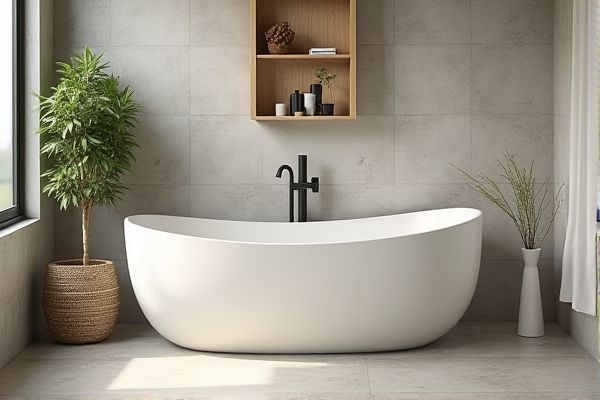
Open toe tubs offer easier access and better ventilation, making them ideal for quicker drying and reduced risk of fungal infections, while closed toe tubs provide more protection and support for your feet during use. Discover which option best suits your needs by exploring the detailed comparison in the rest of the article.
Table of Comparison
| Feature | Open Toe Tub | Closed Toe Tub |
|---|---|---|
| Design | Exposes toes, open front | Fully enclosed front covering toes |
| Ventilation | Better air flow, keeps feet cool | Limited air flow, more enclosed |
| Comfort | Ideal for warm weather | Provides full foot protection |
| Hygiene | Easier drying, less moisture buildup | May retain moisture, needs regular cleaning |
| Safety | Less protection for toes | Protects toes from impact and debris |
| Use Cases | Suitable for pedicures, casual baths | Preferred in medical or therapeutic settings |
| Material | Typically lightweight, breathable | Often more durable, supportive |
Introduction to Open Toe Tubs vs Closed Toe Tubs
Open toe tubs provide greater air circulation and are ideal for individuals who prefer extra ventilation and easier access during pedicures. Closed toe tubs offer comprehensive protection and warmth, making them suitable for treatments requiring steady heat retention and enhanced foot coverage. Choosing between open toe and closed toe tubs depends on personal preference, treatment goals, and comfort requirements in spa pedicure services.
Key Design Differences
Open toe tubs feature a cutout at the front, allowing your feet to extend beyond the tub edge for easy access and enhanced comfort during soaking sessions. Closed toe tubs have a fully enclosed design, providing a snug, warm environment that retains heat more effectively and offers greater coverage for relaxation. These key design differences influence your bathing experience by balancing accessibility with insulation and support.
Comfort and Accessibility
Open toe tubs enhance comfort by allowing easier access for individuals with mobility issues, reducing the need to lift legs over high edges and offering a more breathable bathing experience. Closed toe tubs provide a more secure and enclosed environment that can support full body immersion, often preferred for warmth and stability during bathing. Accessibility in open toe tubs caters to users requiring quick entry and exit, while closed toe tubs are better suited for those who benefit from additional support and containment.
Safety Considerations
Open toe tubs provide easier drainage and reduce the risk of slipping by allowing water to flow freely, but they may increase the chance of accidental foot injuries due to exposed toes. Closed toe tubs offer enhanced protection for your feet by fully enclosing them, minimizing the risk of cuts or stubbing, especially in busy or cluttered environments. Your choice should balance accessibility with safety, considering the specific needs of your bathing area and personal mobility.
Aesthetic Appeal and Style
Open toe tubs offer a modern, sleek aesthetic that enhances contemporary bathroom designs by providing a sense of openness and lightness, while closed toe tubs present a classic, streamlined look that complements traditional and minimalist styles. The open design allows for more visual flow, making spaces appear larger and more inviting, whereas closed toe tubs provide a solid, structured appearance that emphasizes elegance and formality. Choosing between open and closed toe tubs depends on the desired ambiance, with open toe tubs favoring casual chic and closed toe tubs suiting sophisticated, timeless interiors.
Installation Requirements
Open toe tubs require less specialized installation space due to their design, allowing easier access for plumbing and maintenance. Closed toe tubs often demand more precise measurements and may necessitate additional framing or support to accommodate the enclosed front panel. Your choice should consider the available bathroom layout and any restrictions imposed by existing plumbing infrastructure.
Maintenance and Cleaning
Open toe tubs typically require more frequent cleaning due to increased exposure to airborne dust and debris, which can settle inside the tub. Closed toe tubs tend to accumulate less external dirt, making maintenance easier and less frequent. Both designs benefit from regular rinsing and mild detergent use to prevent soap scum and residue buildup, ensuring hygiene and longevity.
Cost Comparison
Open toe tubs generally cost less than closed toe tubs due to simpler design and reduced materials needed for manufacturing. Closed toe tubs offer enhanced foot protection and support, which may increase their price by 15-30% compared to open toe models. Choosing between them depends on balancing budget constraints with specific comfort and safety requirements.
Best Uses and Ideal Settings
Open toe tubs are best suited for spa environments and relaxation areas where easy access and foot ventilation are priorities, ideal for pedicures and soothing foot Soaks. Closed toe tubs provide enhanced warmth and maintain water temperature longer, making them ideal for therapeutic treatments and medical settings focused on hydrotherapy and joint pain relief. Both designs cater to specific user needs, with open toe tubs favored in casual wellness centers and closed toe tubs preferred in clinical and rehabilitation facilities.
Choosing the Right Tub for Your Bathroom
Open toe tubs offer a modern, spacious feel that enhances bathroom aesthetics and provides easy access, making them ideal for those seeking comfort and style. Closed toe tubs ensure privacy and warmth, perfect for people who prefer a traditional bathing experience with full coverage. Your choice depends on bathroom size, personal preference, and the desired ambiance, balancing functionality and design.
 homyna.com
homyna.com